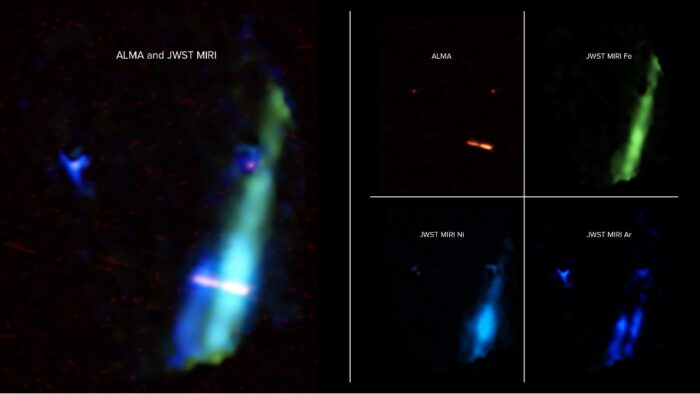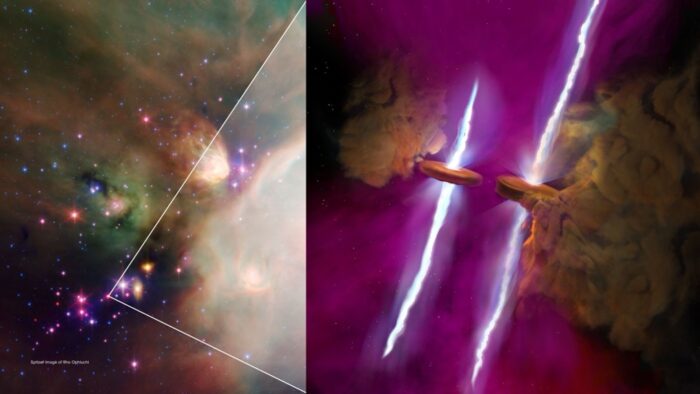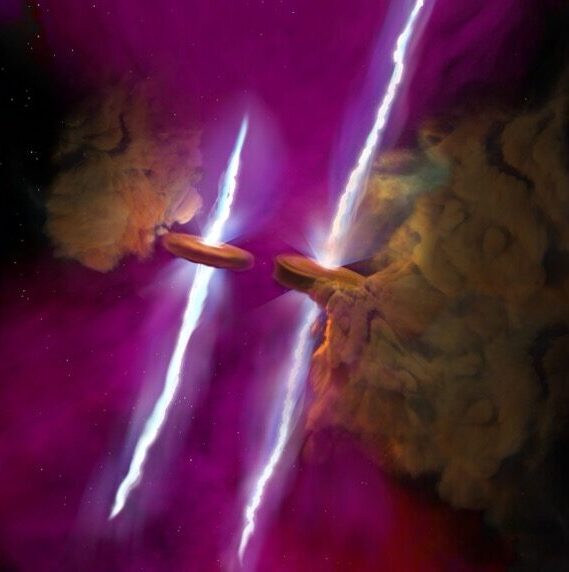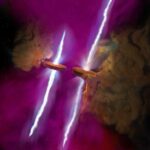It's Twins! Astronomers Discover Parallel Disks and Jets Erupting from a Pair of Young Stars
12 June, 2024 / Read time: 5 minutes
Most of the Universe is invisible to the human eye. The building blocks of stars are only revealed in wavelengths outside the visible spectrum. Astronomers recently used two very different and powerful telescopes to discover twin disks and twin parallel jets erupting from young stars in a multiple-star system. This discovery was unexpected and unprecedented, given the stars, disks, and jets' age, size, and chemical makeup. Their location in a known, well-studied part of the Universe adds to the thrill.
Atacama Large Millimeter/submillimeter Array (ALMA) and NASA's James Webb Space Telescope's (JWST) Mid-Infrared Instrument (MIRI) were combined for this research.
ALMA and JWST's MIRI observe very different parts of the electromagnetic spectrum. Using them together allowed astronomers to discover these twins, hidden in radio and infrared wavelengths in star system WL20, located in the nearby rho Ophiuchi molecular cloud complex, over 400 light years away from the Earth's Solar System.
"What we discovered was absolutely wild," shares astronomer Mary Barsony, "We've known about star system WL20 for a long time. But what caught our attention is that one of the stars in the system appeared much younger than the rest. Using MIRI and ALMA together, we actually saw that this ONE star was TWO stars right next to each other. A disk surrounded each of these stars, and each disc was emitting jets parallel to the other."
ALMA spotted the discs, while MIRI found the jets. Co-author Valentin J.M. Le Gouellec of NASA-ARC retrieved and reduced ALMA archival data to reveal the discs' composition. At the same time, Lukasz Tychoniec of Leiden Observatory provided high-resolution images showing the discs' massive size, approximately 100 times the distance between the Earth and the Sun. Another co-author, Martijn L. van Gelder, provided resources to process the data collected by MIRI, revealing the chemical makeup of the jets.
Adds Barsony, "So if it weren't for MIRI, we wouldn't even know that these jets existed, which is amazing." ALMA's high-resolution observations of the disks surrounding the two newly observed stars revealed the disks' structure, as Barsony explains, "Someone looking at this ALMA data not knowing there were twin jets would think, oh, it's a large edge on disk with a central hole, instead of two edges on disks and two jets. That's pretty remarkable."
Another remarkable thing about this discovery is that it may never have had the opportunity to happen. JPL scientist Michael Ressler explains, "Much of the research about binary protostars focuses on a few nearby star-forming regions. I had been awarded some observing time with JWST and chose to split it into a few small projects. For one project, I decided to study binaries in the Perseus star-forming region. However, I had been studying WL20, which is in the rho Ophiuchus region in nearly the opposite part of the sky, for nearly 30 years, and I thought, 'why not sneak it in? I'll never get another chance, even if it doesn't quite fit with the others.' We had a very fortunate accident with what we found; the results are stunning."
By combining multi-wavelength data from ALMA and JWST, these new findings shed light on the complex processes involved in forming multiple star systems. Astronomers plan to utilize ALMA's future upgraded capabilities, like the Wideband Sensitivity Upgrade, to continue unraveling the mysteries surrounding the birth of stars and planetary systems.
Additional Information
This research was presented in the 244th Meeting of the American Astronomical Society.
The Atacama Large Millimeter/submillimeter Array (ALMA), an international astronomy facility, is a partnership of the European Southern Observatory (ESO), the U.S. National Science Foundation (NSF) and the National Institutes of Natural Sciences (NINS) of Japan in cooperation with the Republic of Chile. ALMA is funded by ESO on behalf of its Member States, by NSF in cooperation with the National Research Council of Canada (NRC) and the National Science and Technology Council (NSTC) in Taiwan and by NINS in cooperation with the Academia Sinica (AS) in Taiwan and the Korea Astronomy and Space Science Institute (KASI).
ALMA construction and operations are led by ESO on behalf of its Member States; by the National Radio Astronomy Observatory (NRAO), managed by Associated Universities, Inc. (AUI), on behalf of North America; and by the National Astronomical Observatory of Japan (NAOJ) on behalf of East Asia. The Joint ALMA Observatory (JAO) provides the unified leadership and management of ALMA's construction, commissioning, and operation.
The James Webb Space Telescope is the world's premier space science observatory. Webb is solving mysteries in our solar system, looking beyond to distant worlds around other stars, and probing the mysterious structures and origins of our Universe and our place in it. Webb is an international program led by NASA with its partners, ESA (European Space Agency) and CSA (Canadian Space Agency).
Images


Contacts
-
Nicolás Lira
Education and Public Outreach Coordinator
Joint ALMA Observatory, Santiago - Chile
Phone: +56 2 2467 6519
Cel: +56 9 9445 7726
Email: [email protected]
-
Jill Malusky
-
Bárbara Ferreira
-
Yuichi Matsuda





